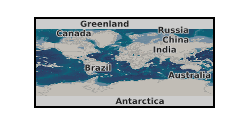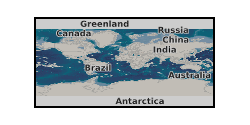Uranium isotopes
Type of resources
Topics
Keywords
Contact for the resource
Provided by
Years
Formats
Update frequencies
-

This data compilation contains uranium isotopes (234U/235U/238U) and concentration data on a suite of terrestrial and extra-terrestrial samples for understanding the uranium isotope cycling on Earth. Sample list includes meteorites (ordinary chondrites, eucrites), mantle-derived basalts (Ocean Island Basalts, Mid-Ocean Ridge Basalts), arc volcanics, altered oceanic crust (ODP 801), volcanici-clastic sediments, seawater, fossil corals and organic-rich sediments (From the Black Sea and Cariaco Basin).
-

Rare earth element, major and minor element, and iron speciation data for nine independent sections in the Nama Group, described in detail in Wood et al., 2015, Precambrian Research, and Tostevin et al., 2016, Nature Communications. Additional data for Zebra River section include sulfur isotopes from carbonate associated sulfate (published in Tostevin et al, 2017, Precambrian Research); Uranium isotope data for carbonates (published in Tostevin et al., 2019, EPSL); Calcium isotope data for carbonates (unpublished).
-

U-Pb isotope ratio data set for numerous phosphate (apatite) grains in two thin section samples of the LL5 S4-6 Chelyabinsk meteorite. One section is of the S4-6 light lithology, and another of the S5-6 dark lithology. Samples analysed were section ‘A' (light lithology) and section ‘B’ (dark lithology) of Chelyabinsk, both from the Open University School of Physical Sciences sample collection. The results demonstrate variability in degree of Pb-loss during collisional reheating from pristine versus damaged apatite crystal domains. These results are reported for a meteorite fall which originally happened near Chelyabinsk in Russia. The results otherwise have no geographic location, as this is a sample of an asteroid. All measurements were made in December 2020. These data were collected using Secondary Ionisation Mass Spectrometry (SIMS) with a CAMECA IMS 1280 at the Institute of Geology and Geophysics, Chinese Academy of Sciences (IGGCAS). The thin sections were polished with colloidal silica, cleaned, and coated with gold prior to analysis. Microtextural information was obtained prior to analysis using a combination of back-scatter-electron, cathodoluminescence, and electron-back-scatter-diffraction analysis. Data were obtained to test hypotheses relating to the competition between macro-to-meso-scale thermally-driven variation in Pb-loss rates versus microscale variation driven by grain-specific features, e.g., fracture networks. An article describing and discussing these results, including further methodological steps in their collection and processing, is due for publication. This information is currently available in preprint form on arXiv: https://arxiv.org/abs/2112.06038
 NERC Data Catalogue Service
NERC Data Catalogue Service